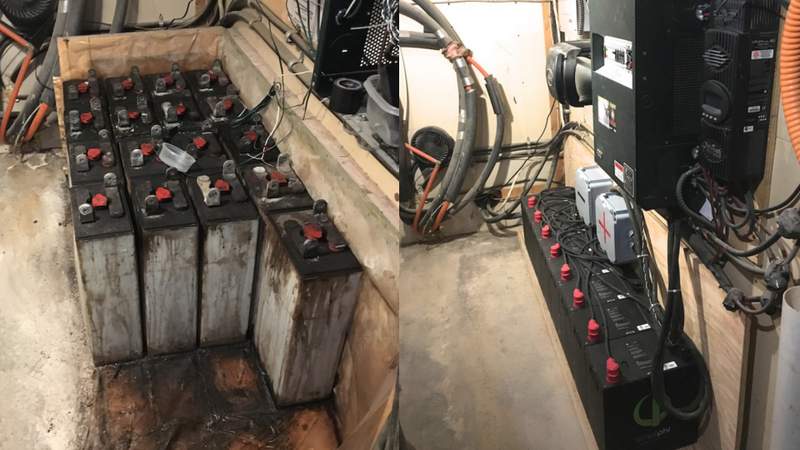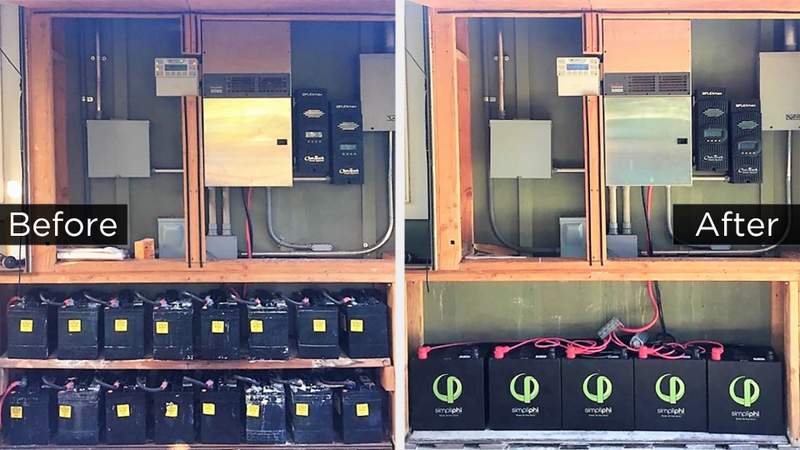For homeowners who live off-grid, prepping for winter weather and months with lower solar production means ensuring that their solar+energy storage system is able to produce enough power to endure long, cold nights and periods of inclement weather. Most off-grid systems rely on flooded lead acid (FLA) batteries to provide storage. As FLA batteries age, lose capacity and no longer produce enough energy to power through winter’s extended darkness, homeowners often find themselves relying on their backup generators more frequently, and often begin searching for alternatives.
For solar installers, this presents an opportunity to talk with off-grid homeowners about making the switch from lead acid to lithium, and in particular, safer, higher efficiency and more reliable lithium ferro phosphate (LFP).
Evaluating the Options
LCOES. Customers often gravitate to lead acid batteries, most often flooded lead acid batteries, because of their lower price point. However, when the FLA’s shallow depth of discharge, prolonged charge and discharge rates and short cycle life are factored in, the overall value and cost savings that LFP batteries provide over their lifetime are significantly greater than their lead acid counterparts. We refer to these advantages as the Levelized Cost of Energy Storage (LCOES).
[Purchase Price (MSRP)]
(#kWh capacity x #DoD) x # efficiency x # cycles = $kWh
The LCOES quantifies the performance metrics of a battery such as the depth of discharge, round trip efficiency rate and cycle life — factors that determine the value per kWh of energy delivered over the full life of the battery. This calculation helps installers and customers understand the overall value of a battery relative to the upfront price and the cost per kWh over its warranted cycle life.
Battery Bank Sizing. Lead acid battery banks are de-rated from their published capacity rate (some by 50%), which means that they cannot be discharged beyond 50% of rated capacity. As such, lead acid battery banks must be up to two- or three-times larger than LFP battery banks in order to provide the same usable energy and power.
Depth of Discharge (DoD). Most FLA battery manufacturers recommend not exceeding 50% DoD for maximum cycle life of their batteries. This means that when you purchase a 500Ah battery, you can only use 250Ah or 50% of what you paid for. You can discharge FLA or VRLA batteries deeper than their recommendations, but this comes at the cost of cycle life — which means you will be replacing and reinvesting in batteries much sooner. The top performing LFP batteries provide 80 to 100 percent DoD. This level of usable energy allows LFP battery banks to deliver the same amount of energy with fewer batteries, which translates to a smaller battery bank, less space, equipment and lower shipping costs. Fewer LFP batteries, combined with a higher round trip efficiency and longer cycle life for the same amount of usable energy very often closes the gap in up front price point.
Efficiency. FLA batteries offer an 85 percent-or-less round-trip efficiency, which is further reduced by ambient temperatures outside a narrow operating window. Leading LFP batteries offer round trip efficiencies as high as 98 percent and a broader operating temperature, eliminating costs associated with the cooling and thermal monitoring required to protect lead acid batteries.
Rate of Charge and Discharge. FLA batteries are typically discharged at a C/20 rate. This rating requires a slow draw of power over 20 hours to protect energy capacity and cycle life. If a lead acid battery is discharged in fewer than 20 hours, the available energy, power and cycle life is reduced. Leading LFP batteries are rated at C/2 and provide their full rated capacity at a two-hour charge and discharge rate. This translates into more usable energy with fewer batteries, even during instances of high-power draw. Therefore, more loads can be powered simultaneously without having to increase the size of the battery bank. The ability to sustain any given load is a function of the batteries and the inverter; not the batteries alone. If the total load exceeds the capability of the inverter power rating (KW), no amount of batteries will suffice.
Another important sizing reality is that lead acid batteries in off-grid systems have a charge rate of 10 or 20 hours, which exceeds a solar day, whereas the best LFP batteries can be charged in two hours. Most FLA battery systems are designed around the capacity at C/20 (general rule of thumb) and marketed as such, however you can charge them faster. A faster charge rate changes the overall capacity rating of the battery and can potentially also change cycle life.
Shelf Life. FLA batteries have a very short shelf life and must be attached to a trickle charging system or routinely charged when in storage. Typical self-discharge rates for FLA can be up to 4% per week, compared to less than 1% – 5% per month for most LFP solutions. This self-discharge rate also comes into play for systems that may be minimally used during a portion of the year, like a seasonal cabin or home, or systems that will be in standby for longer periods of time. FLA manufacturers require no more than six-month of difference in manufacturing date within a single battery bank, due to imbalances that can occur and are not easily remedied. LFP batteries can be stored for long periods without maintenance or degradation.
Storage. Lead acid batteries can be severely damaged if stored for long periods of time at a low state of charge. LFP batteries do not develop a “memory” or reduced rated capacity when stored at a low state of charge. Internal power electronics prevent LFP batteries from being over-discharged or overcharged.
Weight. LFP batteries weigh significantly less and are smaller in size for the same amount of usable energy than lead acid batteries, which makes transport less expensive and installation without heavy equipment possible.
Maintenance. FLA batteries require monthly maintenance checks such at testing specific gravity and voltage as well as watering batteries with distilled water. LFP batteries do not require any maintenance.
Operating Temperature. FLA battery performance is sensitive to ambient temperatures. LFP battery capacity and cycle life are not noticeably affected by variations in ambient temperature. As long as LFP batteries are operated within their 32°to 120° charging temperature window, expect LFP batteries to operate at their full rated capacity.
Safety. FLA batteries require precautionary housing and ventilation to prevent exposure to caustic acid and toxic hydrogen off-gassing. That is why they are frequently installed within a cabinet that allows for dangerous fumes to be vented outdoors. Many times, FLA batteries also have exposed terminals, which can cause hazards when left exposed for children, pets and the occasional mishap of dropping a metal object on top of them. LFP batteries have no explosive hydrogen gas build up, sulfuric acid ground contamination, offensive odor or other safety issues.
Warranty & Lifetime. Depending on the type (AGM, VRLA, FLA), lead acid batteries often reach end-of-life after five years. Leading LFP batteries have a ten-year warranty, which minimizes replacement costs, reduces trips back to an installation, and provides a robust and enduring solution for your customers without maintenance requirements.
Battery Bank Sizing. Some LFP batteries are designed as a drop-in replacement for lead acid batteries. In these types of retrofits, all that is required is to change the programming of the existing charge controller and inverter.
Three steps for retrofitting a lead-acid battery bank with LFP
Step 1 – Compute Depth of Discharge or Usable Storage
A typical lead acid battery operates between 30 to 50%. This means, at most, only half of the total energy storage capacity is available for use. Leading LFP batteries, by comparison, operate between 80 – 100% DoD, which yields a much larger amount of usable energy. This DoD gain is critical when sizing a lead acid battery bank to avoid mistaking total rated energy storage with usable energy storage.
Ÿ LFP replacement battery: 3.8kWh @ 48V
Ÿ Current lead acid bank: 428Ah @ 48V
1. Calculate the total energy storage of the lead acid battery bank:
Lead acid = 428Ah x 48V = 20,544 Watt-hours of total energy storage capacity
2. Factor in a DoD of 50%:
20,544 Watt-hours x 0.5 = 10,272 Watt-hours usable @ 50% DoD
3. Calculate LFP replacement battery capacity
3.8 kWh = 3,800 Watt-hours of total energy storage capacity
4. Factor in a DoD of 80%:
3,800 Watt-hours x 0.8 = 3,040 Watt-hours usable @ 80% DoD
The 428Ah, 48V bank of 8 batteries would be replaced with:
10,272 Watt-hours ÷3,040 Watt-hours = 3.4 x 3.8 kWh batteries. Rounding up, this means it would only require 4 x 3.8 kWh batteries to replace this bank of 8 lead acid batteries.
Step 2 – Compute Efficiency
Efficiency also plays a key factor when upgrading a lead acid battery bank to LFP. Lead acid efficiencies vary drastically based on charge rate and temperature. Look for the exact efficiency on the battery’s spec sheet or installation manual. If the exact efficiency is not available, using a standard 85% for lead acid can often suffice as a reliable average when computing efficiency upgrades.
The highest quality LFP batteries have a high round-trip efficiency of 98% that is not significantly affected by factors such as charge rate and temperature.
Expanding on the DoD computations above with an efficiency calculation:
Take the calculations from step one and factor in efficiency
- Lead-acid: 10,272 Watt-hours x 0.85 = 8,731 Watt-hours at 85% efficiency
- LFP battery: 3,040 Watt-hours x 0.98 = 2,979.2 Watt-hours at 98% efficiency
With the Depth of Discharge and efficiency rate calculations you can determine the appropriate LFP battery bank replacement size.
Step 3: Re-program existing equipment
The inverters and charge controllers must be re-programmed to manage the LFP charge and discharge curves.
For inverters and charge controllers, the following parameters must be changed.
1. Absorb volts
2. Float volts (or disable float)
3. EQ Volts (or disable equalization)
4. Temperature compensation (zero-out or disable)
5. Absorb time: change to 1 hour for LFP. Here is where you can expound on shorter charge time for LFP.
6. Battery capacity: change to capacity of the new LFP battery bank
7. For inverters, which may use an external generator as a power source, one must set the charge rate such that the batteries are not charged beyond C/2.
Catherine Von Burg is the president of SimpliPhi.
— Solar Builder magazine


Leave a Reply
You must be logged in to post a comment.